International Trade Report: Iron Ore and Steel Market Opportunities
VerifiedAdded on 2020/04/07
|27
|4701
|453
Report
AI Summary
This report provides a detailed analysis of the international trade landscape for iron ore and steel, focusing on market opportunities and strategic recommendations. It begins with an introduction to the global iron ore market and the significance of steel as a major product derived from iron ore. The report explores the current market dynamics, highlighting the importance of iron ore derivatives, the challenges in the iron market, and the competitive environment within the steel industry. It identifies opportunities for steel in the next two years, including the impact of China's steel production and the potential for portfolio diversification. The report recommends a fundamental trading strategy, outlines risk management practices, and concludes with a summary of key findings and references. Annexures provide additional data on global iron ore exporters, steel production, and trade statistics.
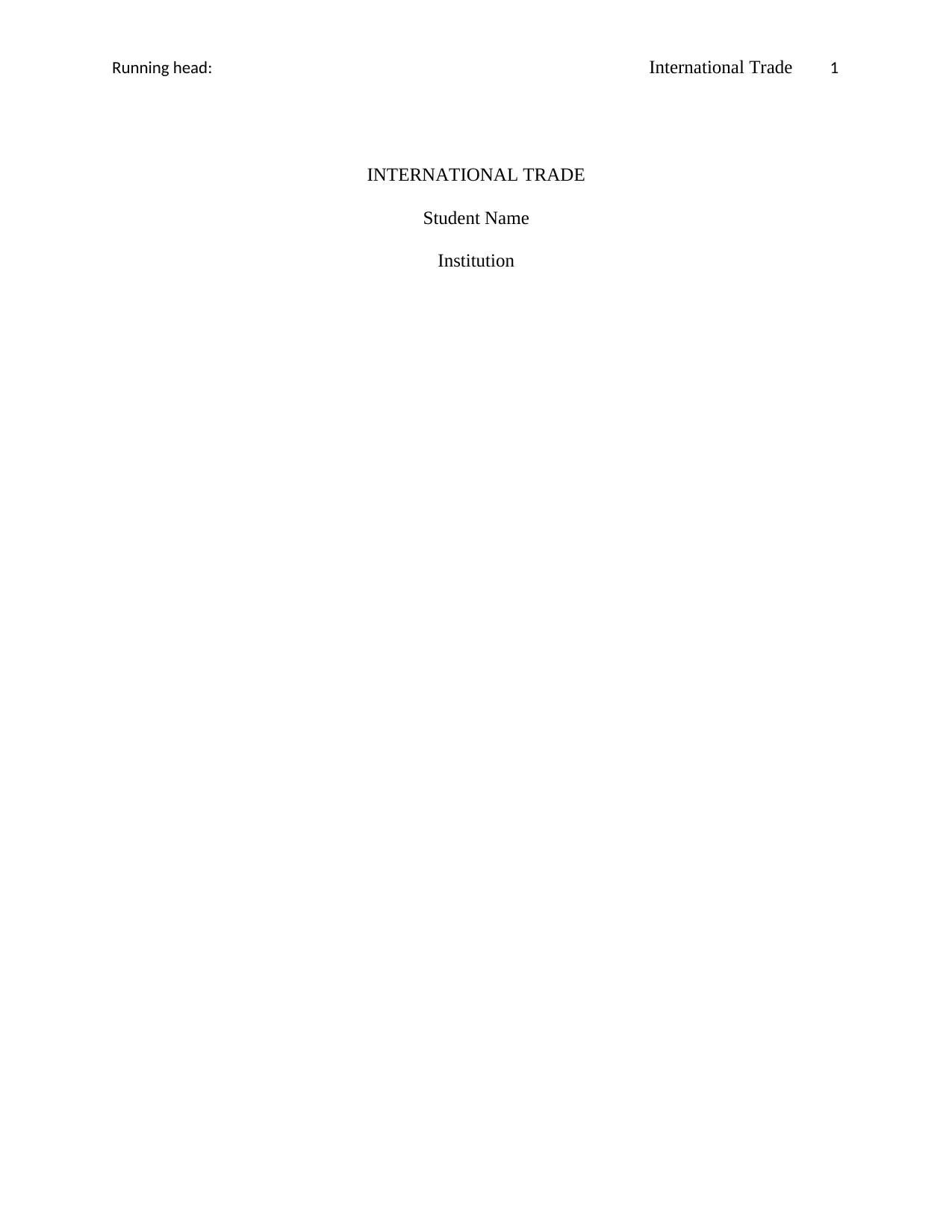
Running head: International Trade 1
INTERNATIONAL TRADE
Student Name
Institution
INTERNATIONAL TRADE
Student Name
Institution
Paraphrase This Document
Need a fresh take? Get an instant paraphrase of this document with our AI Paraphraser
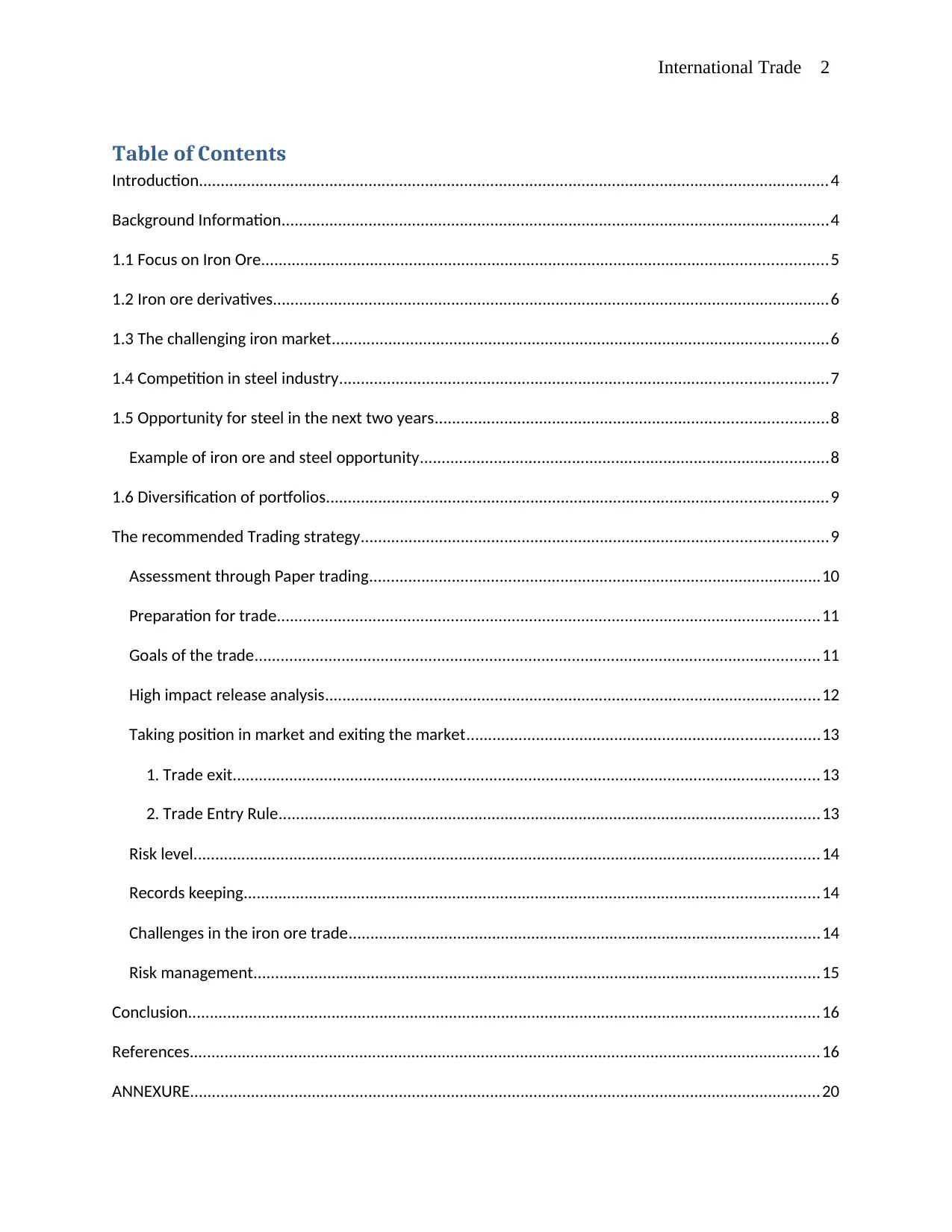
International Trade 2
Table of Contents
Introduction.................................................................................................................................................4
Background Information..............................................................................................................................4
1.1 Focus on Iron Ore..................................................................................................................................5
1.2 Iron ore derivatives................................................................................................................................6
1.3 The challenging iron market..................................................................................................................6
1.4 Competition in steel industry................................................................................................................7
1.5 Opportunity for steel in the next two years..........................................................................................8
Example of iron ore and steel opportunity..............................................................................................8
1.6 Diversification of portfolios...................................................................................................................9
The recommended Trading strategy...........................................................................................................9
Assessment through Paper trading........................................................................................................10
Preparation for trade.............................................................................................................................11
Goals of the trade..................................................................................................................................11
High impact release analysis..................................................................................................................12
Taking position in market and exiting the market.................................................................................13
1. Trade exit.......................................................................................................................................13
2. Trade Entry Rule............................................................................................................................13
Risk level................................................................................................................................................14
Records keeping....................................................................................................................................14
Challenges in the iron ore trade............................................................................................................14
Risk management..................................................................................................................................15
Conclusion.................................................................................................................................................16
References.................................................................................................................................................16
ANNEXURE.................................................................................................................................................20
Table of Contents
Introduction.................................................................................................................................................4
Background Information..............................................................................................................................4
1.1 Focus on Iron Ore..................................................................................................................................5
1.2 Iron ore derivatives................................................................................................................................6
1.3 The challenging iron market..................................................................................................................6
1.4 Competition in steel industry................................................................................................................7
1.5 Opportunity for steel in the next two years..........................................................................................8
Example of iron ore and steel opportunity..............................................................................................8
1.6 Diversification of portfolios...................................................................................................................9
The recommended Trading strategy...........................................................................................................9
Assessment through Paper trading........................................................................................................10
Preparation for trade.............................................................................................................................11
Goals of the trade..................................................................................................................................11
High impact release analysis..................................................................................................................12
Taking position in market and exiting the market.................................................................................13
1. Trade exit.......................................................................................................................................13
2. Trade Entry Rule............................................................................................................................13
Risk level................................................................................................................................................14
Records keeping....................................................................................................................................14
Challenges in the iron ore trade............................................................................................................14
Risk management..................................................................................................................................15
Conclusion.................................................................................................................................................16
References.................................................................................................................................................16
ANNEXURE.................................................................................................................................................20
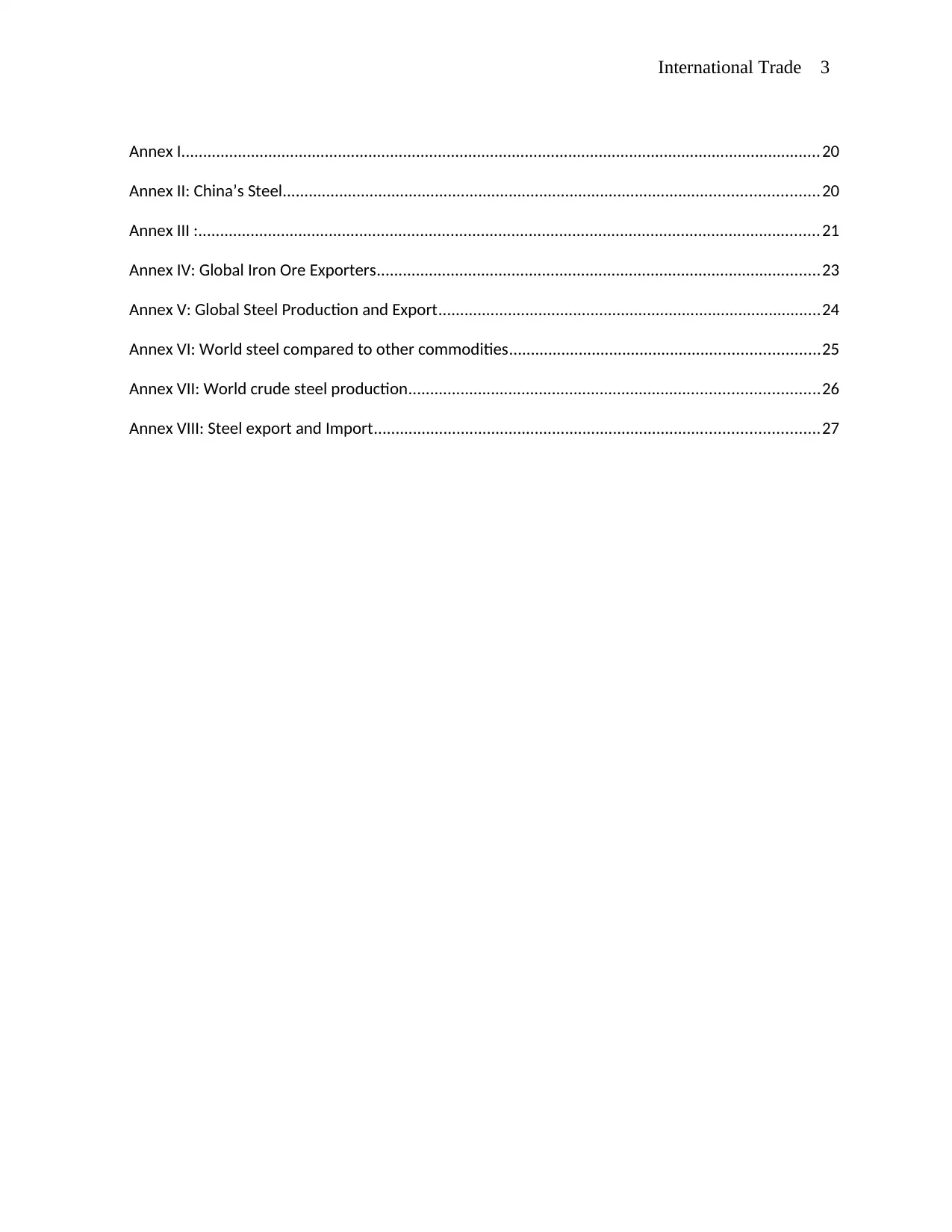
International Trade 3
Annex I...................................................................................................................................................20
Annex II: China’s Steel...........................................................................................................................20
Annex III :...............................................................................................................................................21
Annex IV: Global Iron Ore Exporters......................................................................................................23
Annex V: Global Steel Production and Export........................................................................................24
Annex VI: World steel compared to other commodities.......................................................................25
Annex VII: World crude steel production..............................................................................................26
Annex VIII: Steel export and Import......................................................................................................27
Annex I...................................................................................................................................................20
Annex II: China’s Steel...........................................................................................................................20
Annex III :...............................................................................................................................................21
Annex IV: Global Iron Ore Exporters......................................................................................................23
Annex V: Global Steel Production and Export........................................................................................24
Annex VI: World steel compared to other commodities.......................................................................25
Annex VII: World crude steel production..............................................................................................26
Annex VIII: Steel export and Import......................................................................................................27
⊘ This is a preview!⊘
Do you want full access?
Subscribe today to unlock all pages.

Trusted by 1+ million students worldwide
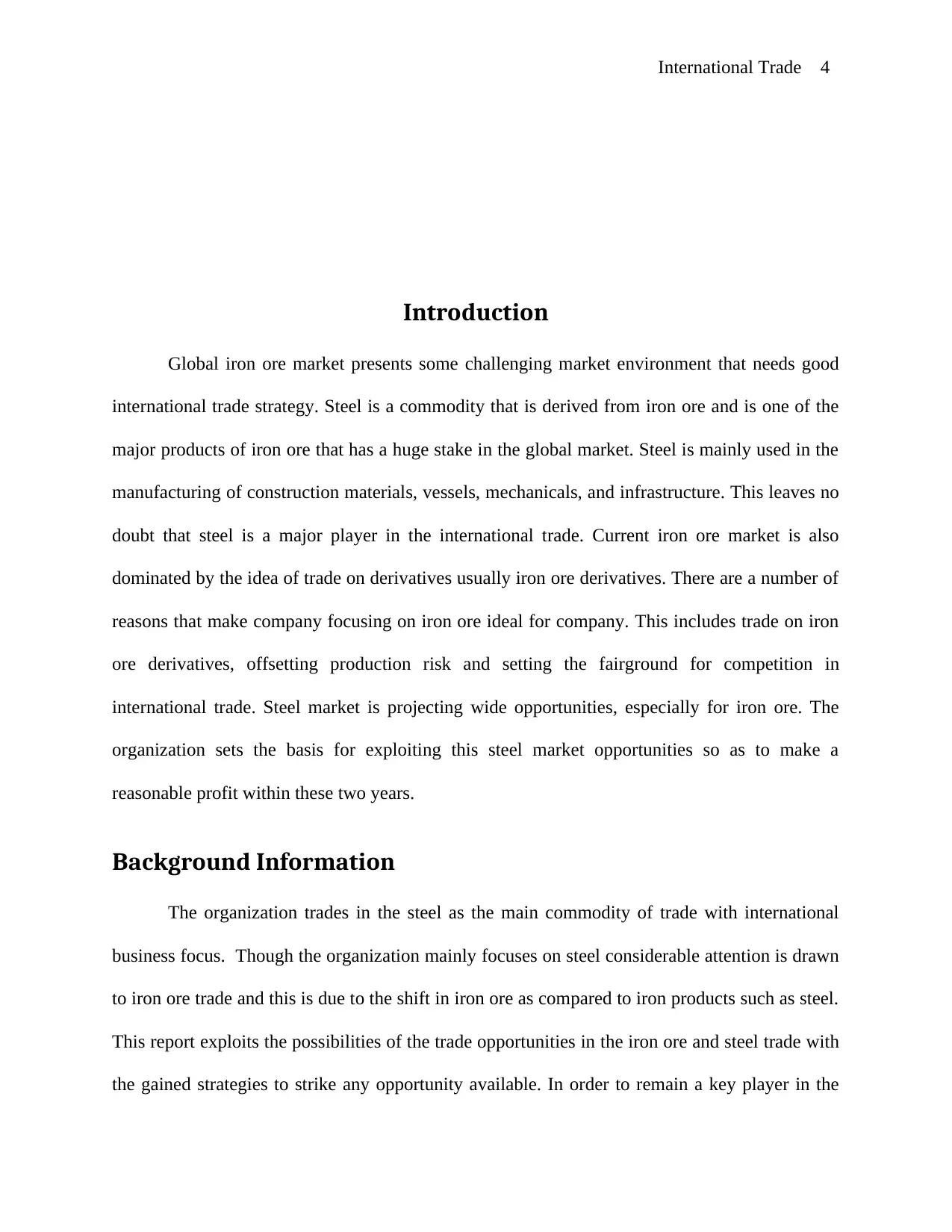
International Trade 4
Introduction
Global iron ore market presents some challenging market environment that needs good
international trade strategy. Steel is a commodity that is derived from iron ore and is one of the
major products of iron ore that has a huge stake in the global market. Steel is mainly used in the
manufacturing of construction materials, vessels, mechanicals, and infrastructure. This leaves no
doubt that steel is a major player in the international trade. Current iron ore market is also
dominated by the idea of trade on derivatives usually iron ore derivatives. There are a number of
reasons that make company focusing on iron ore ideal for company. This includes trade on iron
ore derivatives, offsetting production risk and setting the fairground for competition in
international trade. Steel market is projecting wide opportunities, especially for iron ore. The
organization sets the basis for exploiting this steel market opportunities so as to make a
reasonable profit within these two years.
Background Information
The organization trades in the steel as the main commodity of trade with international
business focus. Though the organization mainly focuses on steel considerable attention is drawn
to iron ore trade and this is due to the shift in iron ore as compared to iron products such as steel.
This report exploits the possibilities of the trade opportunities in the iron ore and steel trade with
the gained strategies to strike any opportunity available. In order to remain a key player in the
Introduction
Global iron ore market presents some challenging market environment that needs good
international trade strategy. Steel is a commodity that is derived from iron ore and is one of the
major products of iron ore that has a huge stake in the global market. Steel is mainly used in the
manufacturing of construction materials, vessels, mechanicals, and infrastructure. This leaves no
doubt that steel is a major player in the international trade. Current iron ore market is also
dominated by the idea of trade on derivatives usually iron ore derivatives. There are a number of
reasons that make company focusing on iron ore ideal for company. This includes trade on iron
ore derivatives, offsetting production risk and setting the fairground for competition in
international trade. Steel market is projecting wide opportunities, especially for iron ore. The
organization sets the basis for exploiting this steel market opportunities so as to make a
reasonable profit within these two years.
Background Information
The organization trades in the steel as the main commodity of trade with international
business focus. Though the organization mainly focuses on steel considerable attention is drawn
to iron ore trade and this is due to the shift in iron ore as compared to iron products such as steel.
This report exploits the possibilities of the trade opportunities in the iron ore and steel trade with
the gained strategies to strike any opportunity available. In order to remain a key player in the
Paraphrase This Document
Need a fresh take? Get an instant paraphrase of this document with our AI Paraphraser
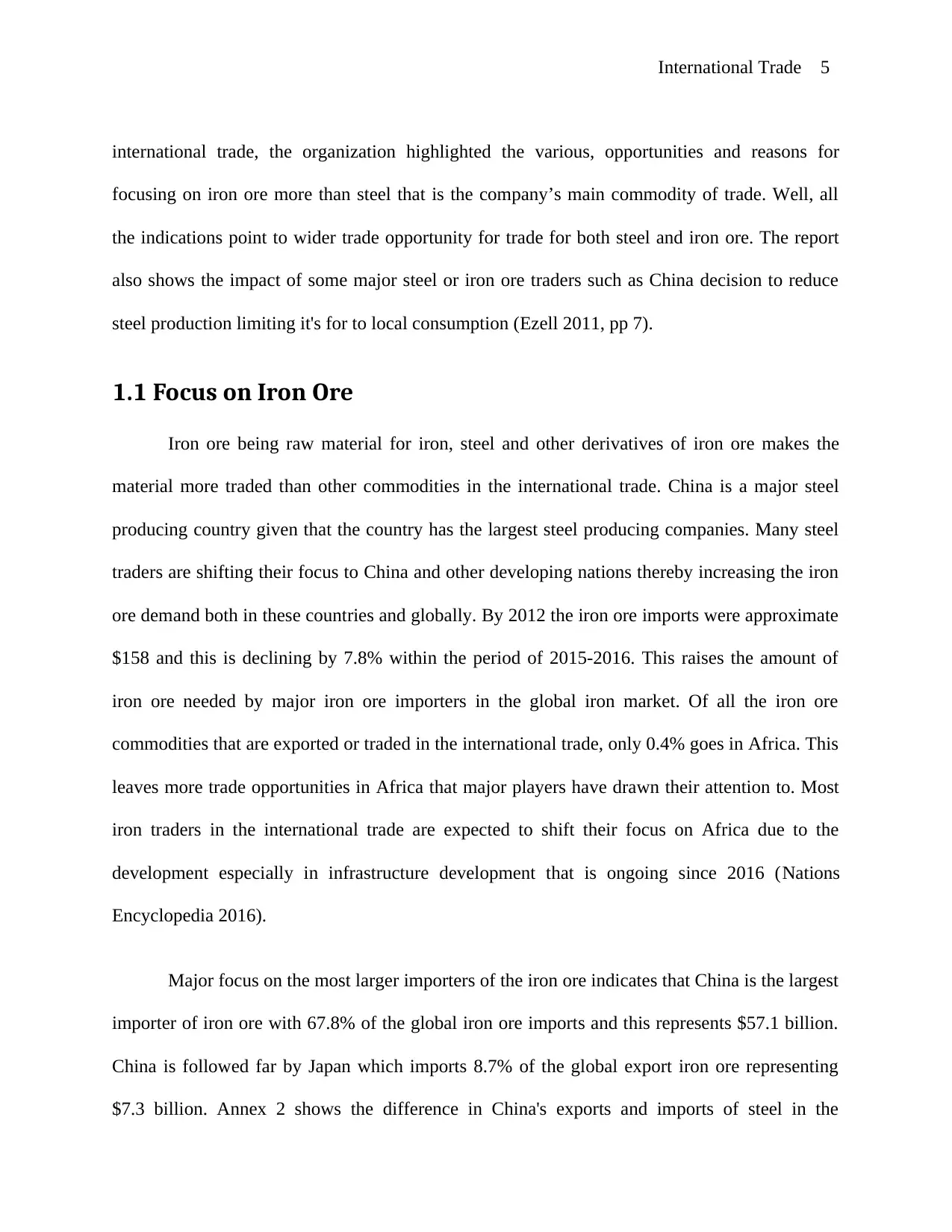
International Trade 5
international trade, the organization highlighted the various, opportunities and reasons for
focusing on iron ore more than steel that is the company’s main commodity of trade. Well, all
the indications point to wider trade opportunity for trade for both steel and iron ore. The report
also shows the impact of some major steel or iron ore traders such as China decision to reduce
steel production limiting it's for to local consumption (Ezell 2011, pp 7).
1.1 Focus on Iron Ore
Iron ore being raw material for iron, steel and other derivatives of iron ore makes the
material more traded than other commodities in the international trade. China is a major steel
producing country given that the country has the largest steel producing companies. Many steel
traders are shifting their focus to China and other developing nations thereby increasing the iron
ore demand both in these countries and globally. By 2012 the iron ore imports were approximate
$158 and this is declining by 7.8% within the period of 2015-2016. This raises the amount of
iron ore needed by major iron ore importers in the global iron market. Of all the iron ore
commodities that are exported or traded in the international trade, only 0.4% goes in Africa. This
leaves more trade opportunities in Africa that major players have drawn their attention to. Most
iron traders in the international trade are expected to shift their focus on Africa due to the
development especially in infrastructure development that is ongoing since 2016 (Nations
Encyclopedia 2016).
Major focus on the most larger importers of the iron ore indicates that China is the largest
importer of iron ore with 67.8% of the global iron ore imports and this represents $57.1 billion.
China is followed far by Japan which imports 8.7% of the global export iron ore representing
$7.3 billion. Annex 2 shows the difference in China's exports and imports of steel in the
international trade, the organization highlighted the various, opportunities and reasons for
focusing on iron ore more than steel that is the company’s main commodity of trade. Well, all
the indications point to wider trade opportunity for trade for both steel and iron ore. The report
also shows the impact of some major steel or iron ore traders such as China decision to reduce
steel production limiting it's for to local consumption (Ezell 2011, pp 7).
1.1 Focus on Iron Ore
Iron ore being raw material for iron, steel and other derivatives of iron ore makes the
material more traded than other commodities in the international trade. China is a major steel
producing country given that the country has the largest steel producing companies. Many steel
traders are shifting their focus to China and other developing nations thereby increasing the iron
ore demand both in these countries and globally. By 2012 the iron ore imports were approximate
$158 and this is declining by 7.8% within the period of 2015-2016. This raises the amount of
iron ore needed by major iron ore importers in the global iron market. Of all the iron ore
commodities that are exported or traded in the international trade, only 0.4% goes in Africa. This
leaves more trade opportunities in Africa that major players have drawn their attention to. Most
iron traders in the international trade are expected to shift their focus on Africa due to the
development especially in infrastructure development that is ongoing since 2016 (Nations
Encyclopedia 2016).
Major focus on the most larger importers of the iron ore indicates that China is the largest
importer of iron ore with 67.8% of the global iron ore imports and this represents $57.1 billion.
China is followed far by Japan which imports 8.7% of the global export iron ore representing
$7.3 billion. Annex 2 shows the difference in China's exports and imports of steel in the
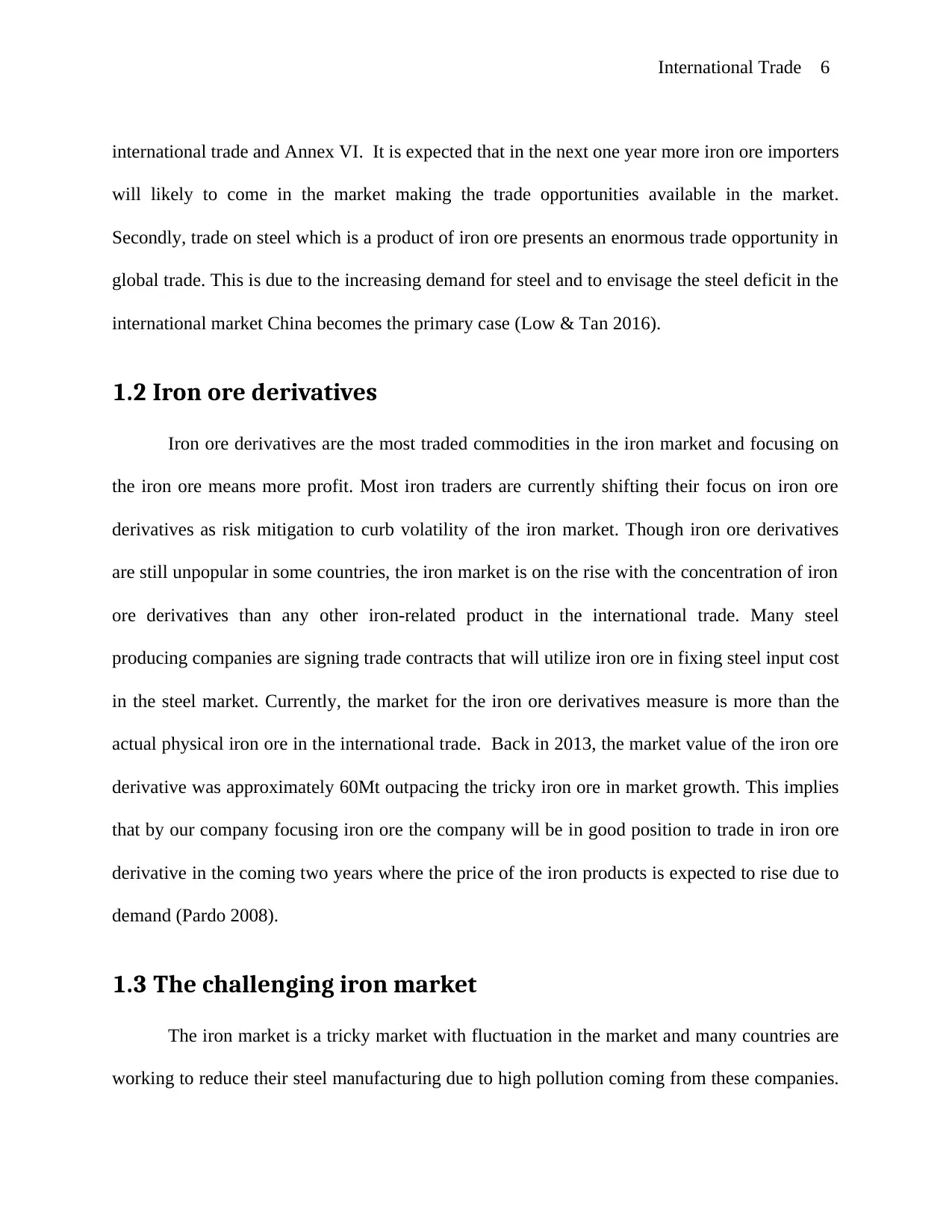
International Trade 6
international trade and Annex VI. It is expected that in the next one year more iron ore importers
will likely to come in the market making the trade opportunities available in the market.
Secondly, trade on steel which is a product of iron ore presents an enormous trade opportunity in
global trade. This is due to the increasing demand for steel and to envisage the steel deficit in the
international market China becomes the primary case (Low & Tan 2016).
1.2 Iron ore derivatives
Iron ore derivatives are the most traded commodities in the iron market and focusing on
the iron ore means more profit. Most iron traders are currently shifting their focus on iron ore
derivatives as risk mitigation to curb volatility of the iron market. Though iron ore derivatives
are still unpopular in some countries, the iron market is on the rise with the concentration of iron
ore derivatives than any other iron-related product in the international trade. Many steel
producing companies are signing trade contracts that will utilize iron ore in fixing steel input cost
in the steel market. Currently, the market for the iron ore derivatives measure is more than the
actual physical iron ore in the international trade. Back in 2013, the market value of the iron ore
derivative was approximately 60Mt outpacing the tricky iron ore in market growth. This implies
that by our company focusing iron ore the company will be in good position to trade in iron ore
derivative in the coming two years where the price of the iron products is expected to rise due to
demand (Pardo 2008).
1.3 The challenging iron market
The iron market is a tricky market with fluctuation in the market and many countries are
working to reduce their steel manufacturing due to high pollution coming from these companies.
international trade and Annex VI. It is expected that in the next one year more iron ore importers
will likely to come in the market making the trade opportunities available in the market.
Secondly, trade on steel which is a product of iron ore presents an enormous trade opportunity in
global trade. This is due to the increasing demand for steel and to envisage the steel deficit in the
international market China becomes the primary case (Low & Tan 2016).
1.2 Iron ore derivatives
Iron ore derivatives are the most traded commodities in the iron market and focusing on
the iron ore means more profit. Most iron traders are currently shifting their focus on iron ore
derivatives as risk mitigation to curb volatility of the iron market. Though iron ore derivatives
are still unpopular in some countries, the iron market is on the rise with the concentration of iron
ore derivatives than any other iron-related product in the international trade. Many steel
producing companies are signing trade contracts that will utilize iron ore in fixing steel input cost
in the steel market. Currently, the market for the iron ore derivatives measure is more than the
actual physical iron ore in the international trade. Back in 2013, the market value of the iron ore
derivative was approximately 60Mt outpacing the tricky iron ore in market growth. This implies
that by our company focusing iron ore the company will be in good position to trade in iron ore
derivative in the coming two years where the price of the iron products is expected to rise due to
demand (Pardo 2008).
1.3 The challenging iron market
The iron market is a tricky market with fluctuation in the market and many countries are
working to reduce their steel manufacturing due to high pollution coming from these companies.
⊘ This is a preview!⊘
Do you want full access?
Subscribe today to unlock all pages.

Trusted by 1+ million students worldwide
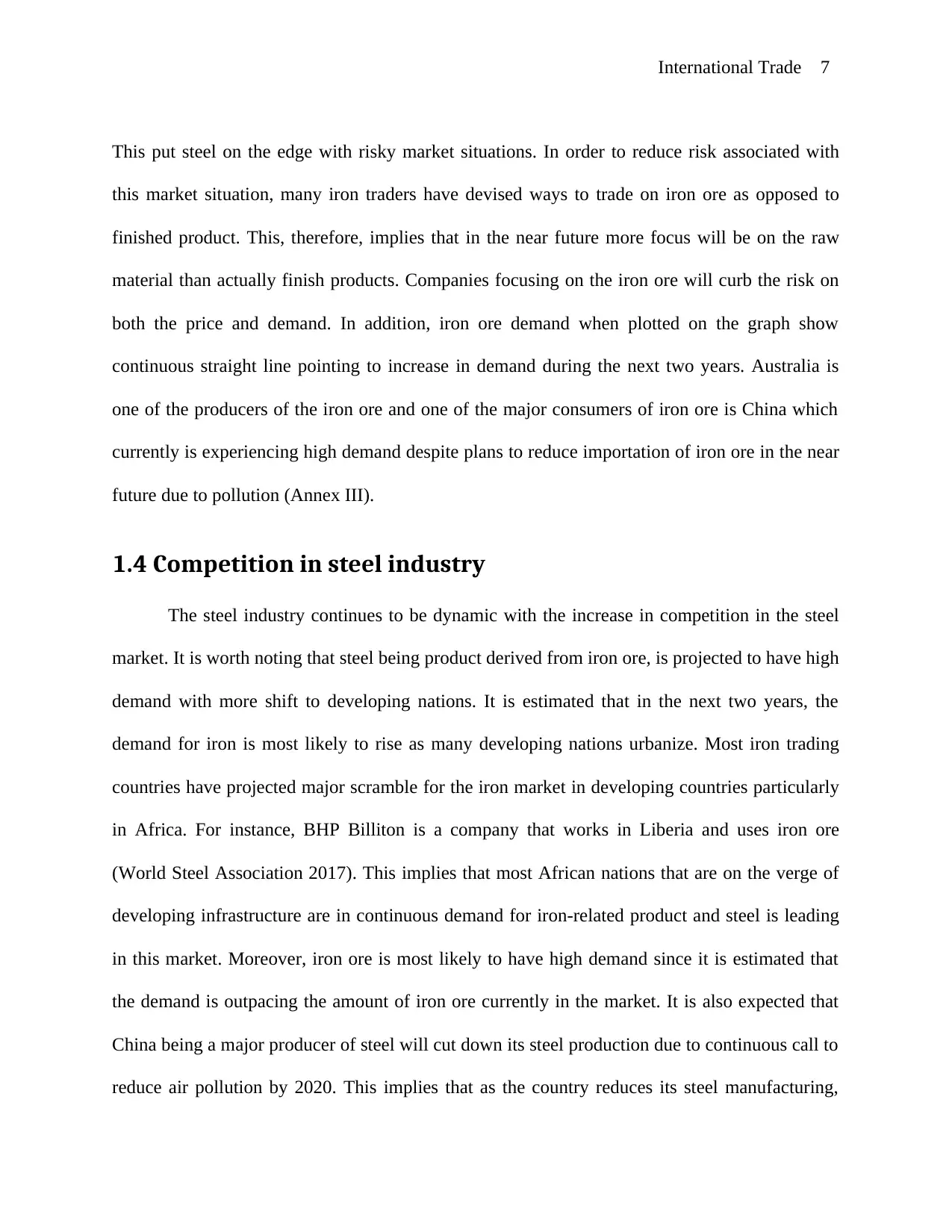
International Trade 7
This put steel on the edge with risky market situations. In order to reduce risk associated with
this market situation, many iron traders have devised ways to trade on iron ore as opposed to
finished product. This, therefore, implies that in the near future more focus will be on the raw
material than actually finish products. Companies focusing on the iron ore will curb the risk on
both the price and demand. In addition, iron ore demand when plotted on the graph show
continuous straight line pointing to increase in demand during the next two years. Australia is
one of the producers of the iron ore and one of the major consumers of iron ore is China which
currently is experiencing high demand despite plans to reduce importation of iron ore in the near
future due to pollution (Annex III).
1.4 Competition in steel industry
The steel industry continues to be dynamic with the increase in competition in the steel
market. It is worth noting that steel being product derived from iron ore, is projected to have high
demand with more shift to developing nations. It is estimated that in the next two years, the
demand for iron is most likely to rise as many developing nations urbanize. Most iron trading
countries have projected major scramble for the iron market in developing countries particularly
in Africa. For instance, BHP Billiton is a company that works in Liberia and uses iron ore
(World Steel Association 2017). This implies that most African nations that are on the verge of
developing infrastructure are in continuous demand for iron-related product and steel is leading
in this market. Moreover, iron ore is most likely to have high demand since it is estimated that
the demand is outpacing the amount of iron ore currently in the market. It is also expected that
China being a major producer of steel will cut down its steel production due to continuous call to
reduce air pollution by 2020. This implies that as the country reduces its steel manufacturing,
This put steel on the edge with risky market situations. In order to reduce risk associated with
this market situation, many iron traders have devised ways to trade on iron ore as opposed to
finished product. This, therefore, implies that in the near future more focus will be on the raw
material than actually finish products. Companies focusing on the iron ore will curb the risk on
both the price and demand. In addition, iron ore demand when plotted on the graph show
continuous straight line pointing to increase in demand during the next two years. Australia is
one of the producers of the iron ore and one of the major consumers of iron ore is China which
currently is experiencing high demand despite plans to reduce importation of iron ore in the near
future due to pollution (Annex III).
1.4 Competition in steel industry
The steel industry continues to be dynamic with the increase in competition in the steel
market. It is worth noting that steel being product derived from iron ore, is projected to have high
demand with more shift to developing nations. It is estimated that in the next two years, the
demand for iron is most likely to rise as many developing nations urbanize. Most iron trading
countries have projected major scramble for the iron market in developing countries particularly
in Africa. For instance, BHP Billiton is a company that works in Liberia and uses iron ore
(World Steel Association 2017). This implies that most African nations that are on the verge of
developing infrastructure are in continuous demand for iron-related product and steel is leading
in this market. Moreover, iron ore is most likely to have high demand since it is estimated that
the demand is outpacing the amount of iron ore currently in the market. It is also expected that
China being a major producer of steel will cut down its steel production due to continuous call to
reduce air pollution by 2020. This implies that as the country reduces its steel manufacturing,
Paraphrase This Document
Need a fresh take? Get an instant paraphrase of this document with our AI Paraphraser
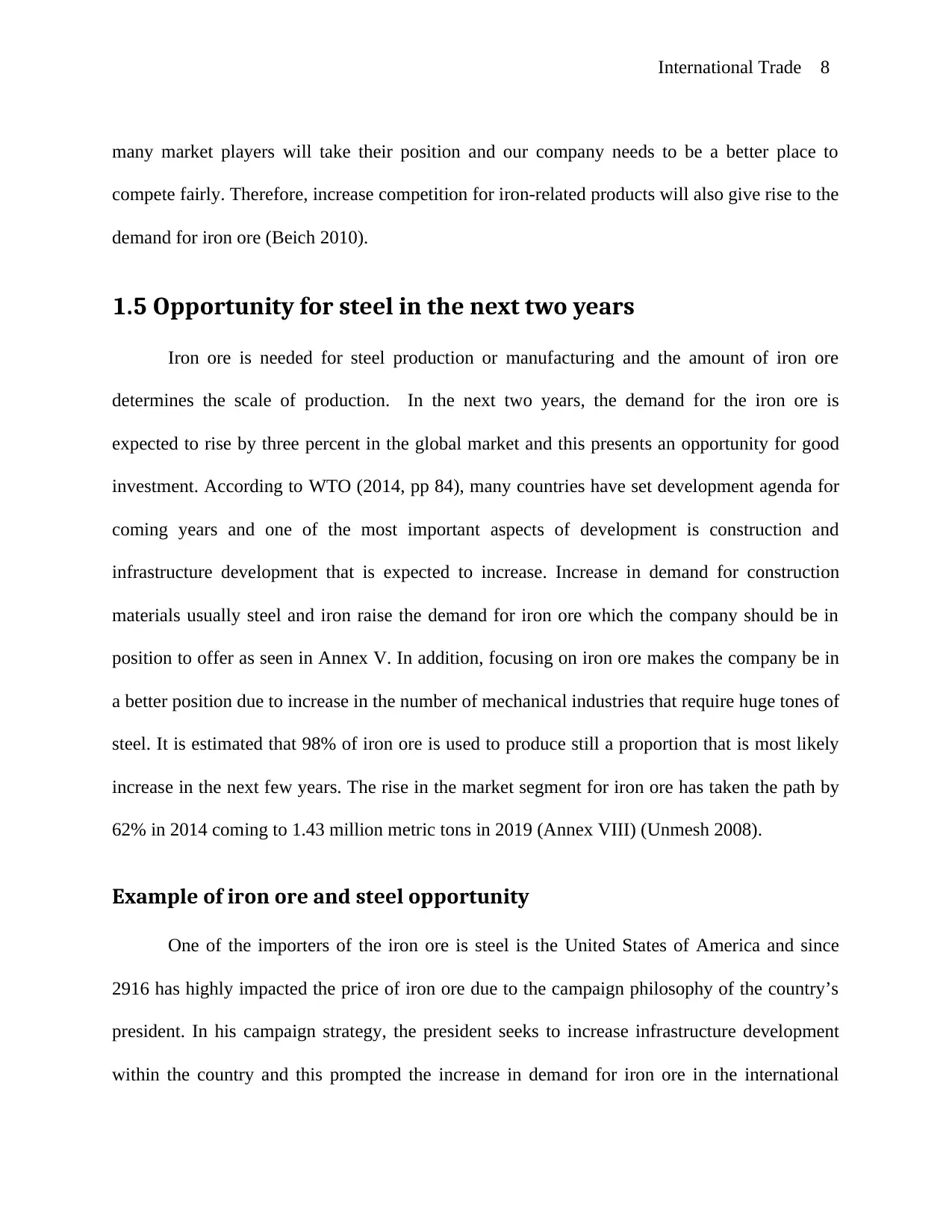
International Trade 8
many market players will take their position and our company needs to be a better place to
compete fairly. Therefore, increase competition for iron-related products will also give rise to the
demand for iron ore (Beich 2010).
1.5 Opportunity for steel in the next two years
Iron ore is needed for steel production or manufacturing and the amount of iron ore
determines the scale of production. In the next two years, the demand for the iron ore is
expected to rise by three percent in the global market and this presents an opportunity for good
investment. According to WTO (2014, pp 84), many countries have set development agenda for
coming years and one of the most important aspects of development is construction and
infrastructure development that is expected to increase. Increase in demand for construction
materials usually steel and iron raise the demand for iron ore which the company should be in
position to offer as seen in Annex V. In addition, focusing on iron ore makes the company be in
a better position due to increase in the number of mechanical industries that require huge tones of
steel. It is estimated that 98% of iron ore is used to produce still a proportion that is most likely
increase in the next few years. The rise in the market segment for iron ore has taken the path by
62% in 2014 coming to 1.43 million metric tons in 2019 (Annex VIII) (Unmesh 2008).
Example of iron ore and steel opportunity
One of the importers of the iron ore is steel is the United States of America and since
2916 has highly impacted the price of iron ore due to the campaign philosophy of the country’s
president. In his campaign strategy, the president seeks to increase infrastructure development
within the country and this prompted the increase in demand for iron ore in the international
many market players will take their position and our company needs to be a better place to
compete fairly. Therefore, increase competition for iron-related products will also give rise to the
demand for iron ore (Beich 2010).
1.5 Opportunity for steel in the next two years
Iron ore is needed for steel production or manufacturing and the amount of iron ore
determines the scale of production. In the next two years, the demand for the iron ore is
expected to rise by three percent in the global market and this presents an opportunity for good
investment. According to WTO (2014, pp 84), many countries have set development agenda for
coming years and one of the most important aspects of development is construction and
infrastructure development that is expected to increase. Increase in demand for construction
materials usually steel and iron raise the demand for iron ore which the company should be in
position to offer as seen in Annex V. In addition, focusing on iron ore makes the company be in
a better position due to increase in the number of mechanical industries that require huge tones of
steel. It is estimated that 98% of iron ore is used to produce still a proportion that is most likely
increase in the next few years. The rise in the market segment for iron ore has taken the path by
62% in 2014 coming to 1.43 million metric tons in 2019 (Annex VIII) (Unmesh 2008).
Example of iron ore and steel opportunity
One of the importers of the iron ore is steel is the United States of America and since
2916 has highly impacted the price of iron ore due to the campaign philosophy of the country’s
president. In his campaign strategy, the president seeks to increase infrastructure development
within the country and this prompted the increase in demand for iron ore in the international
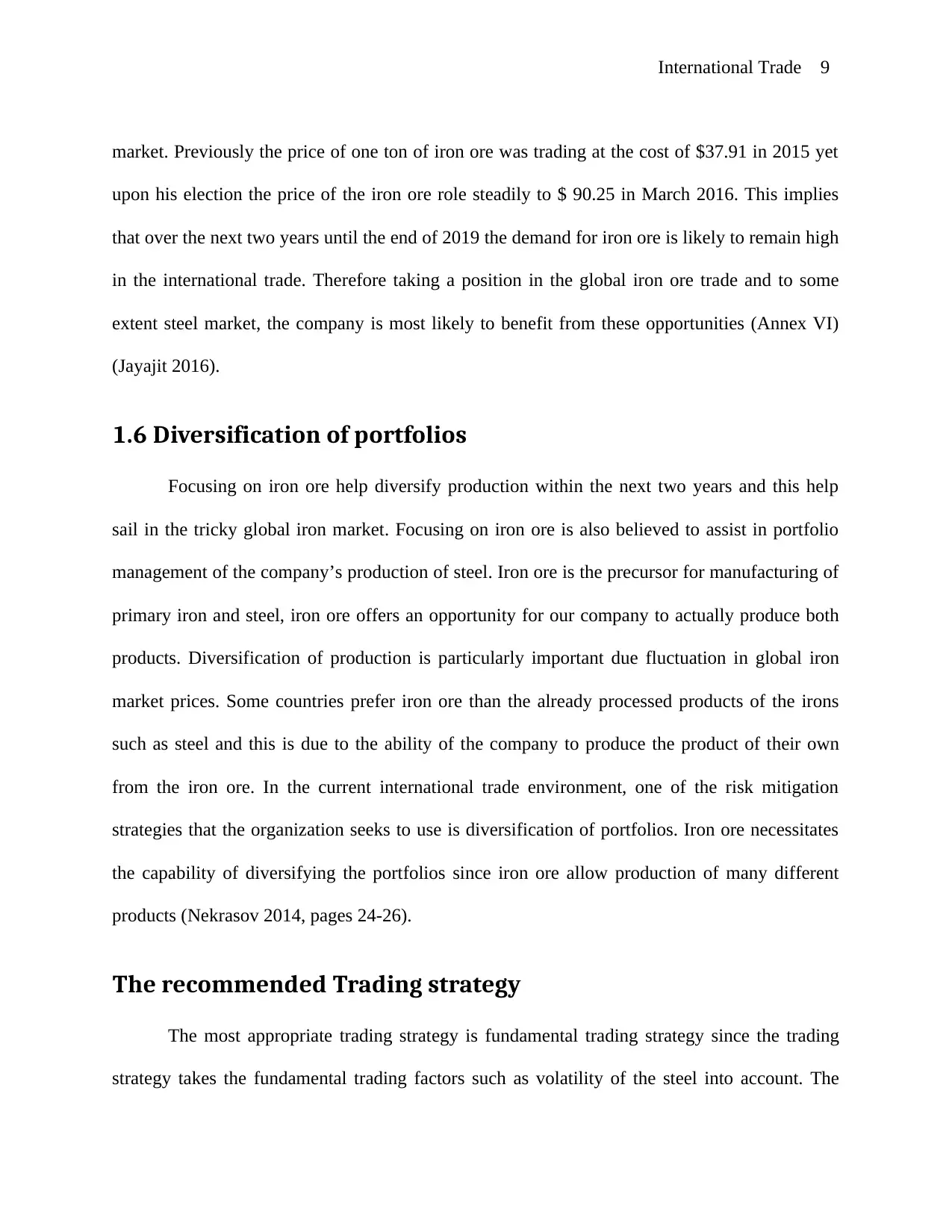
International Trade 9
market. Previously the price of one ton of iron ore was trading at the cost of $37.91 in 2015 yet
upon his election the price of the iron ore role steadily to $ 90.25 in March 2016. This implies
that over the next two years until the end of 2019 the demand for iron ore is likely to remain high
in the international trade. Therefore taking a position in the global iron ore trade and to some
extent steel market, the company is most likely to benefit from these opportunities (Annex VI)
(Jayajit 2016).
1.6 Diversification of portfolios
Focusing on iron ore help diversify production within the next two years and this help
sail in the tricky global iron market. Focusing on iron ore is also believed to assist in portfolio
management of the company’s production of steel. Iron ore is the precursor for manufacturing of
primary iron and steel, iron ore offers an opportunity for our company to actually produce both
products. Diversification of production is particularly important due fluctuation in global iron
market prices. Some countries prefer iron ore than the already processed products of the irons
such as steel and this is due to the ability of the company to produce the product of their own
from the iron ore. In the current international trade environment, one of the risk mitigation
strategies that the organization seeks to use is diversification of portfolios. Iron ore necessitates
the capability of diversifying the portfolios since iron ore allow production of many different
products (Nekrasov 2014, pages 24-26).
The recommended Trading strategy
The most appropriate trading strategy is fundamental trading strategy since the trading
strategy takes the fundamental trading factors such as volatility of the steel into account. The
market. Previously the price of one ton of iron ore was trading at the cost of $37.91 in 2015 yet
upon his election the price of the iron ore role steadily to $ 90.25 in March 2016. This implies
that over the next two years until the end of 2019 the demand for iron ore is likely to remain high
in the international trade. Therefore taking a position in the global iron ore trade and to some
extent steel market, the company is most likely to benefit from these opportunities (Annex VI)
(Jayajit 2016).
1.6 Diversification of portfolios
Focusing on iron ore help diversify production within the next two years and this help
sail in the tricky global iron market. Focusing on iron ore is also believed to assist in portfolio
management of the company’s production of steel. Iron ore is the precursor for manufacturing of
primary iron and steel, iron ore offers an opportunity for our company to actually produce both
products. Diversification of production is particularly important due fluctuation in global iron
market prices. Some countries prefer iron ore than the already processed products of the irons
such as steel and this is due to the ability of the company to produce the product of their own
from the iron ore. In the current international trade environment, one of the risk mitigation
strategies that the organization seeks to use is diversification of portfolios. Iron ore necessitates
the capability of diversifying the portfolios since iron ore allow production of many different
products (Nekrasov 2014, pages 24-26).
The recommended Trading strategy
The most appropriate trading strategy is fundamental trading strategy since the trading
strategy takes the fundamental trading factors such as volatility of the steel into account. The
⊘ This is a preview!⊘
Do you want full access?
Subscribe today to unlock all pages.

Trusted by 1+ million students worldwide
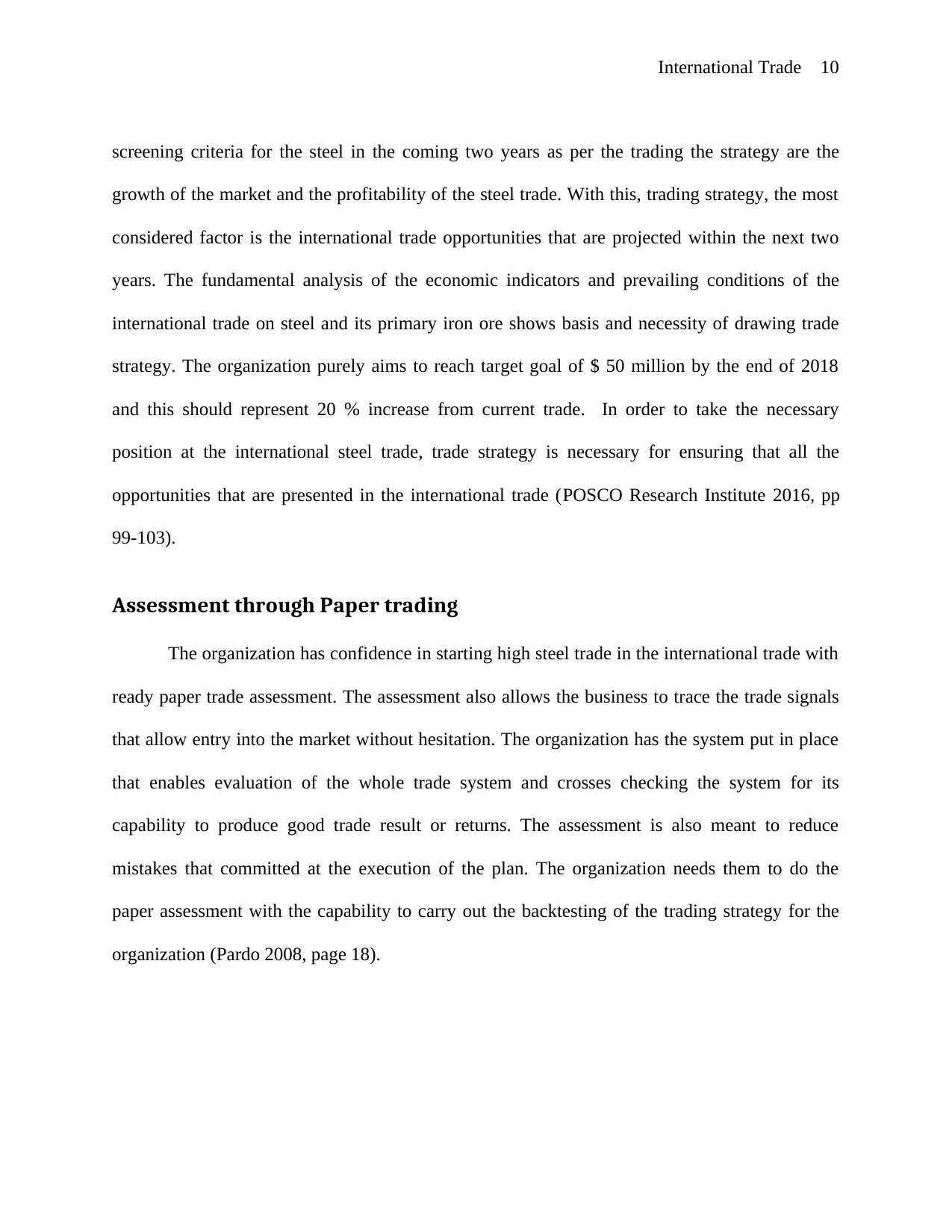
International Trade 10
screening criteria for the steel in the coming two years as per the trading the strategy are the
growth of the market and the profitability of the steel trade. With this, trading strategy, the most
considered factor is the international trade opportunities that are projected within the next two
years. The fundamental analysis of the economic indicators and prevailing conditions of the
international trade on steel and its primary iron ore shows basis and necessity of drawing trade
strategy. The organization purely aims to reach target goal of $ 50 million by the end of 2018
and this should represent 20 % increase from current trade. In order to take the necessary
position at the international steel trade, trade strategy is necessary for ensuring that all the
opportunities that are presented in the international trade (POSCO Research Institute 2016, pp
99-103).
Assessment through Paper trading
The organization has confidence in starting high steel trade in the international trade with
ready paper trade assessment. The assessment also allows the business to trace the trade signals
that allow entry into the market without hesitation. The organization has the system put in place
that enables evaluation of the whole trade system and crosses checking the system for its
capability to produce good trade result or returns. The assessment is also meant to reduce
mistakes that committed at the execution of the plan. The organization needs them to do the
paper assessment with the capability to carry out the backtesting of the trading strategy for the
organization (Pardo 2008, page 18).
screening criteria for the steel in the coming two years as per the trading the strategy are the
growth of the market and the profitability of the steel trade. With this, trading strategy, the most
considered factor is the international trade opportunities that are projected within the next two
years. The fundamental analysis of the economic indicators and prevailing conditions of the
international trade on steel and its primary iron ore shows basis and necessity of drawing trade
strategy. The organization purely aims to reach target goal of $ 50 million by the end of 2018
and this should represent 20 % increase from current trade. In order to take the necessary
position at the international steel trade, trade strategy is necessary for ensuring that all the
opportunities that are presented in the international trade (POSCO Research Institute 2016, pp
99-103).
Assessment through Paper trading
The organization has confidence in starting high steel trade in the international trade with
ready paper trade assessment. The assessment also allows the business to trace the trade signals
that allow entry into the market without hesitation. The organization has the system put in place
that enables evaluation of the whole trade system and crosses checking the system for its
capability to produce good trade result or returns. The assessment is also meant to reduce
mistakes that committed at the execution of the plan. The organization needs them to do the
paper assessment with the capability to carry out the backtesting of the trading strategy for the
organization (Pardo 2008, page 18).
Paraphrase This Document
Need a fresh take? Get an instant paraphrase of this document with our AI Paraphraser
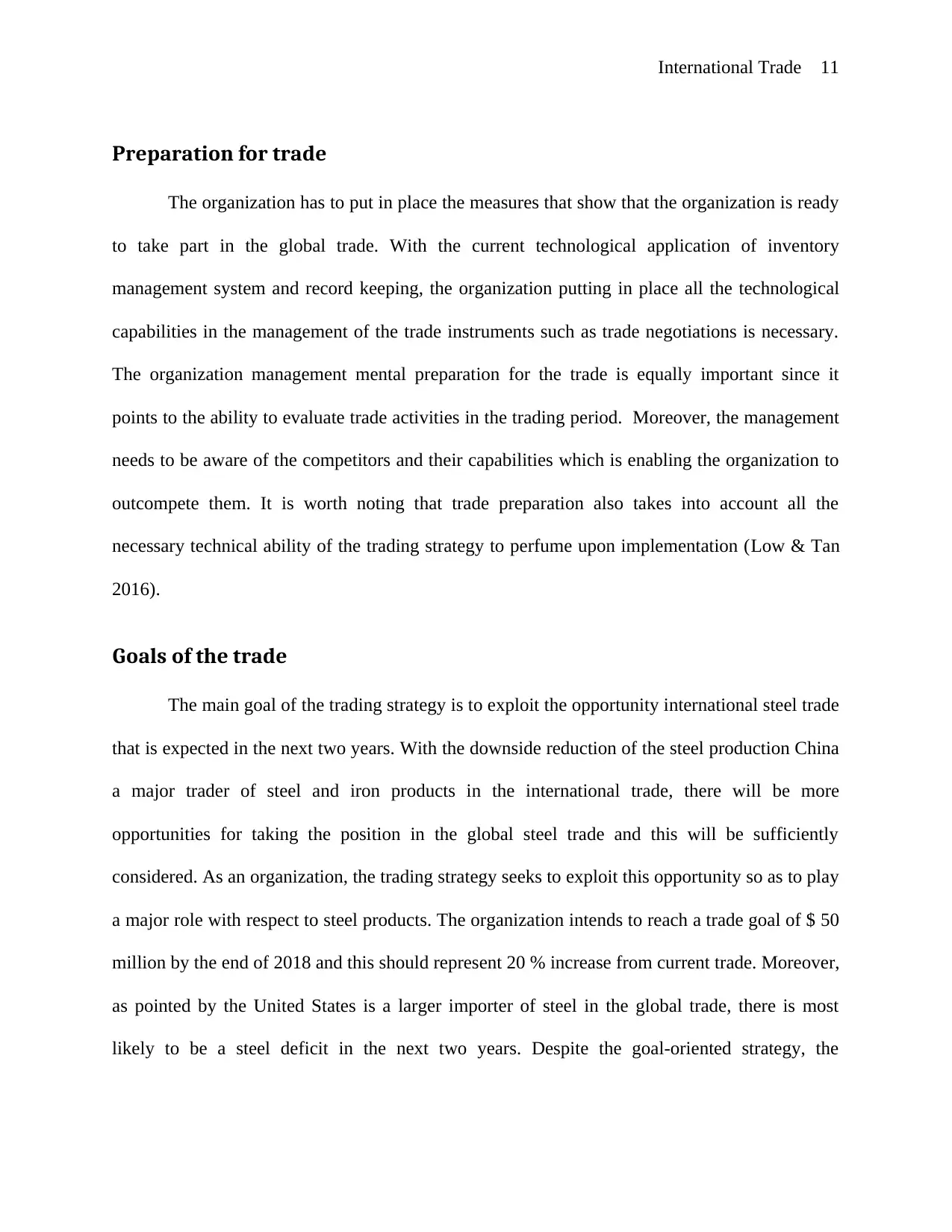
International Trade 11
Preparation for trade
The organization has to put in place the measures that show that the organization is ready
to take part in the global trade. With the current technological application of inventory
management system and record keeping, the organization putting in place all the technological
capabilities in the management of the trade instruments such as trade negotiations is necessary.
The organization management mental preparation for the trade is equally important since it
points to the ability to evaluate trade activities in the trading period. Moreover, the management
needs to be aware of the competitors and their capabilities which is enabling the organization to
outcompete them. It is worth noting that trade preparation also takes into account all the
necessary technical ability of the trading strategy to perfume upon implementation (Low & Tan
2016).
Goals of the trade
The main goal of the trading strategy is to exploit the opportunity international steel trade
that is expected in the next two years. With the downside reduction of the steel production China
a major trader of steel and iron products in the international trade, there will be more
opportunities for taking the position in the global steel trade and this will be sufficiently
considered. As an organization, the trading strategy seeks to exploit this opportunity so as to play
a major role with respect to steel products. The organization intends to reach a trade goal of $ 50
million by the end of 2018 and this should represent 20 % increase from current trade. Moreover,
as pointed by the United States is a larger importer of steel in the global trade, there is most
likely to be a steel deficit in the next two years. Despite the goal-oriented strategy, the
Preparation for trade
The organization has to put in place the measures that show that the organization is ready
to take part in the global trade. With the current technological application of inventory
management system and record keeping, the organization putting in place all the technological
capabilities in the management of the trade instruments such as trade negotiations is necessary.
The organization management mental preparation for the trade is equally important since it
points to the ability to evaluate trade activities in the trading period. Moreover, the management
needs to be aware of the competitors and their capabilities which is enabling the organization to
outcompete them. It is worth noting that trade preparation also takes into account all the
necessary technical ability of the trading strategy to perfume upon implementation (Low & Tan
2016).
Goals of the trade
The main goal of the trading strategy is to exploit the opportunity international steel trade
that is expected in the next two years. With the downside reduction of the steel production China
a major trader of steel and iron products in the international trade, there will be more
opportunities for taking the position in the global steel trade and this will be sufficiently
considered. As an organization, the trading strategy seeks to exploit this opportunity so as to play
a major role with respect to steel products. The organization intends to reach a trade goal of $ 50
million by the end of 2018 and this should represent 20 % increase from current trade. Moreover,
as pointed by the United States is a larger importer of steel in the global trade, there is most
likely to be a steel deficit in the next two years. Despite the goal-oriented strategy, the
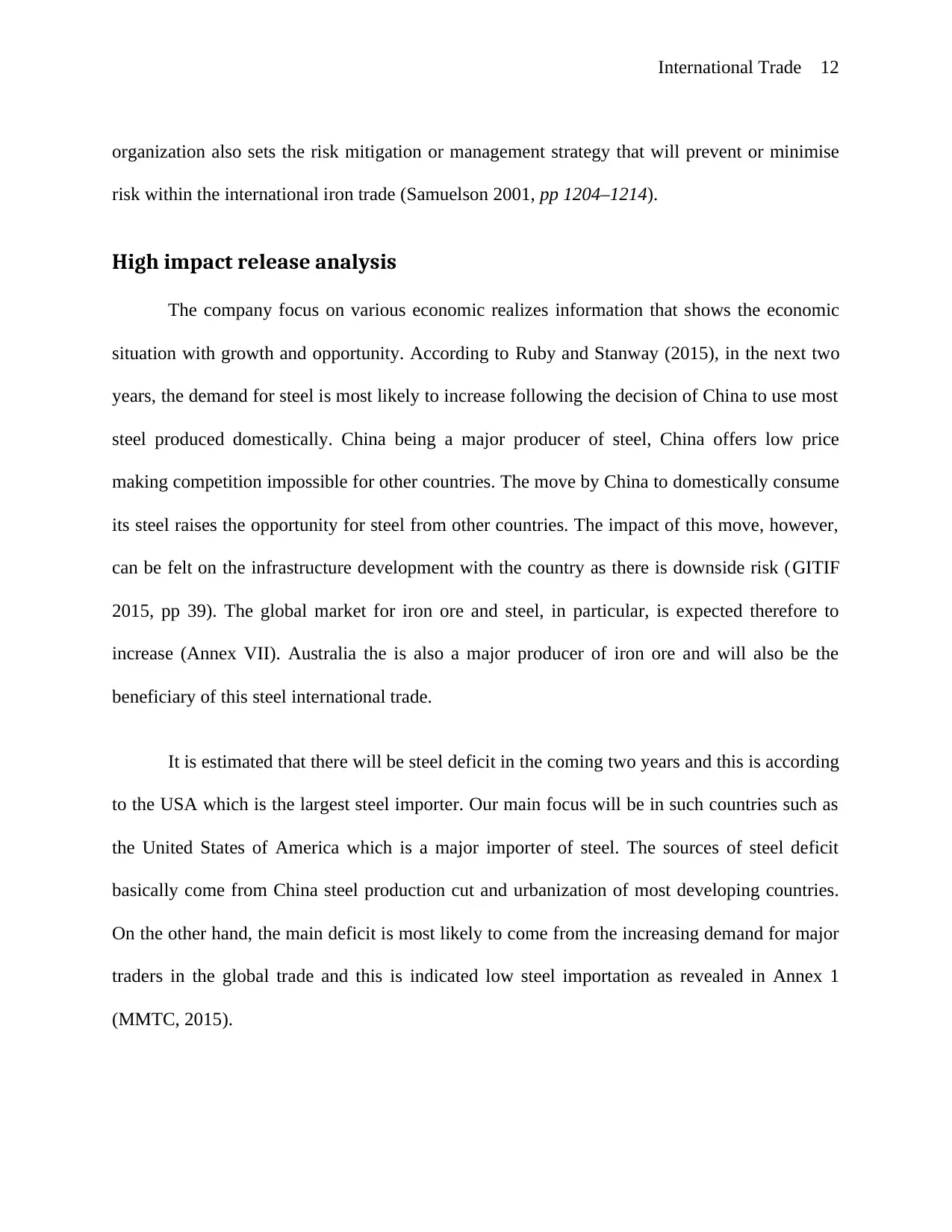
International Trade 12
organization also sets the risk mitigation or management strategy that will prevent or minimise
risk within the international iron trade (Samuelson 2001, pp 1204–1214).
High impact release analysis
The company focus on various economic realizes information that shows the economic
situation with growth and opportunity. According to Ruby and Stanway (2015), in the next two
years, the demand for steel is most likely to increase following the decision of China to use most
steel produced domestically. China being a major producer of steel, China offers low price
making competition impossible for other countries. The move by China to domestically consume
its steel raises the opportunity for steel from other countries. The impact of this move, however,
can be felt on the infrastructure development with the country as there is downside risk (GITIF
2015, pp 39). The global market for iron ore and steel, in particular, is expected therefore to
increase (Annex VII). Australia the is also a major producer of iron ore and will also be the
beneficiary of this steel international trade.
It is estimated that there will be steel deficit in the coming two years and this is according
to the USA which is the largest steel importer. Our main focus will be in such countries such as
the United States of America which is a major importer of steel. The sources of steel deficit
basically come from China steel production cut and urbanization of most developing countries.
On the other hand, the main deficit is most likely to come from the increasing demand for major
traders in the global trade and this is indicated low steel importation as revealed in Annex 1
(MMTC, 2015).
organization also sets the risk mitigation or management strategy that will prevent or minimise
risk within the international iron trade (Samuelson 2001, pp 1204–1214).
High impact release analysis
The company focus on various economic realizes information that shows the economic
situation with growth and opportunity. According to Ruby and Stanway (2015), in the next two
years, the demand for steel is most likely to increase following the decision of China to use most
steel produced domestically. China being a major producer of steel, China offers low price
making competition impossible for other countries. The move by China to domestically consume
its steel raises the opportunity for steel from other countries. The impact of this move, however,
can be felt on the infrastructure development with the country as there is downside risk (GITIF
2015, pp 39). The global market for iron ore and steel, in particular, is expected therefore to
increase (Annex VII). Australia the is also a major producer of iron ore and will also be the
beneficiary of this steel international trade.
It is estimated that there will be steel deficit in the coming two years and this is according
to the USA which is the largest steel importer. Our main focus will be in such countries such as
the United States of America which is a major importer of steel. The sources of steel deficit
basically come from China steel production cut and urbanization of most developing countries.
On the other hand, the main deficit is most likely to come from the increasing demand for major
traders in the global trade and this is indicated low steel importation as revealed in Annex 1
(MMTC, 2015).
⊘ This is a preview!⊘
Do you want full access?
Subscribe today to unlock all pages.

Trusted by 1+ million students worldwide
1 out of 27
Related Documents
Your All-in-One AI-Powered Toolkit for Academic Success.
+13062052269
info@desklib.com
Available 24*7 on WhatsApp / Email
![[object Object]](/_next/static/media/star-bottom.7253800d.svg)
Unlock your academic potential
Copyright © 2020–2025 A2Z Services. All Rights Reserved. Developed and managed by ZUCOL.



![Report on Product Opportunity Analysis in Austria [Year]](/_next/image/?url=https%3A%2F%2Fdesklib.com%2Fmedia%2Fimages%2Fsj%2F0212bd4ad7154997be1049fbb1fb1439.jpg&w=256&q=75)
